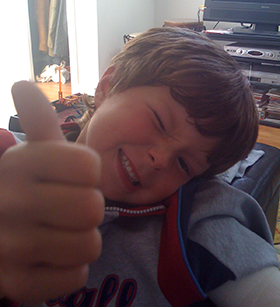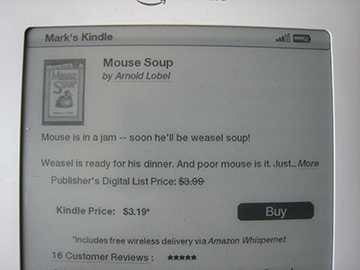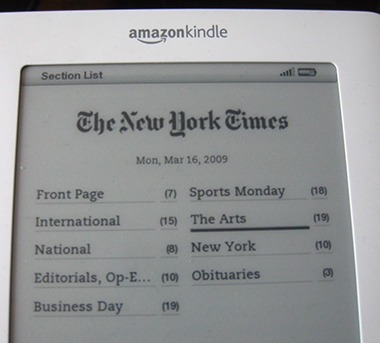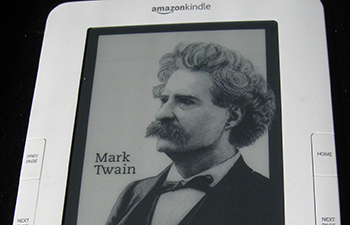I am what you might call the late early adopter. Rather than live on the bleeding edge, I wait safely until Version 2 comes out with the bugs and problems fixed. I got Windows 98 in ’99, waited for the iPhone 3G, and checked out the Kindle 2 rather than 1.
But when my e-book reader from Amazon arrived in late February, it was quickly scooped up by my 6-year-old son, Julian, who has proven his “digital native” chops by downloading dozens of iPhone games and playing a variety of computer games when he has the chance (limited to one hour per week). It didn’t take long for him to start downloading childrens books on the Kindle, especially because all he has to do is click the “Buy” button and the book appears a minute or two later.

My motivation in checking out the Kindle 2 was to see whether this device was going to really change the way I read books and other print publications, whether it had a chance to supplant older media, and whether it was something I needed — or just a passing fancy. And as a side thought, What Would Julian Do? (WWJD?)
So here’s a breakdown on the various ways the Kindle 2 compares to print publications, both in my own experiences over the past few weeks, the thoughts of friends who have seen it and test-drove it, and the thoughts straight from a voracious-reading 6-year-old.
Design/Interface
The first thing I wanted to do when I first turned on the Kindle 2 was start touching the screen. I guess that’s what happens after you’ve had the iPhone. Another friend did the same thing, and I had to keep telling him it’s not a touch-screen. Instead you have to use a square joystick to bring up the menu, go to the Kindle Store, turn off wireless, and other functions.
While it took some time for me to get used to the interface, the joystick and the navigation of books and other publications, my son Julian figured it out with minimal instructions. At first, he was completely hooked on the Kindle, started downloading a bunch of books (until I had to cut him off), and was even reading it at a restaurant when we were out for dinner.
The Kindle has a nice feel to it — not too heavy, not too lightweight. The battery life is very long, and doesn’t really need a recharge more than once every couple days unless you use it more than a few hours each day. While it’s obviously smaller than the printed versions of all the books it can hold (1,500!), it’s not small enough to fit in your pocket, which means it’s yet another device you have to carry around — and charge.
One thing I don’t like is the power switch, which you have to slide for some amount of time to turn the Kindle on and off. Sometimes you get stuck with a screen saver when you just want to turn it off. And even while writing this review, I had a problem getting the device to turn on, and had to reset it to work. And later, I couldn’t get it to turn off without resetting the device. What’s wrong with having a simple on/off switch?
Julian talks about ease of use:
Convenience Factor
The two biggest selling points for the Kindle are the convenience factor for travel, and how simple and quick it is to download reading material. The fact that you can take the equivalent of a stack of books, newspapers and magazines with you in one small device means you can travel much lighter. One friend who is stationed in the Navy in the Middle East mentioned that this would be a big selling point for her. That also goes for people who have to move residences pretty often, because moving a Kindle is a lot easier than boxing up a shelf of books.

When it comes time to upload more content onto your Kindle, the process is a breeze. You go into the Store, search for content you want, and then hit the “Buy” button. The Kindle has built-in cell access on Sprint’s network, so as long as you have a good cell signal, you can download your purchased book within a few minutes. And even when Julian bought a book he didn’t really want, it was pretty simple to cancel the order after the fact without getting charged.
Screen
One of the innovative features of the Kindle is its E-Ink screen that doesn’t have glare in the sunlight. The Kindle 2’s screen was very responsive, loading new pages in books very quickly (something that took longer in the Kindle 1). You can make text bigger or smaller to your liking, and the pictures have nice detail. Still, a major drawback is that the screen is black and white — and can’t play video. And the web browsing experience is severely limited.
Those limitations were especially problematic for Julian. While he was initially wowed by the Kindle, he quickly went back to print books because of the pictures. “I like pictures in a real book because they’re not just black and white,” Julian said.
Cost & Selection
The biggest barrier to mass adoption of e-readers isn’t necessarily that people are wedded to print publications. It’s the high cost of the devices, especially in recessionary times. The Kindle costs $359, and you’ll need a carrying case to take it on the road. While buying books for the Kindle is much cheaper than the print versions — about $10 for most new titles and $3 to $5 for kids books — that startup cost is hard to swallow. It’s even more difficult when you know that this is just a transitional device that will be quickly surpassed by new ones with color screens, Internet access and more.
The question most people have asked me about Kindle: Is it worth it? That’s obviously subjective, and depends how much disposable income you have at this point. I think for heavy readers and heavy travelers, it makes a lot of sense. A friend who had been traveling to beaches recently said they couldn’t believe how many Kindles they saw people reading.
Another factor to consider is the selection of books you can get on the Kindle. Amazon touts the 250,000 titles available, but that doesn’t satisfy everyone. Julian was upset that they didn’t carry too many kids books, and when I asked him whether he would recommend it to his friends, he was blunt: “No, because they don’t have all the books I want.” Another downside is that you can’t get free public domain books very easily.
Julian talks about the environmental aspect of the Kindle:
Newspapers & Magazines
The Kindle also offers a variety of subscriptions to newspapers like the New York Times and magazines like Newsweek and even blogs like Boing Boing. While you can try these publications for two-week trials, you still have to pay a premium to read them after the trials end. The Times, for instance, costs 75 cents per issue or $13.99 per month, a good chunk of money for something you can get online for free. Plus, the interface for Kindle e-pubs lacks the browsability you get with real print publications, and you have to go through a table of contents to look over stories before reading them. And there’s no way to leave comments on stories or email them to friends.

Still, when I was on a weekend retreat recently with the Kindle, I ended up reading almost the entire Sunday New York Times rather than the books I had downloaded. I think I read more of the Times than I would have in print. If and when my local newspaper, the San Francisco Chronicle, stops coming to my doorstep, I would consider getting a Kindle subscription to that paper for $5.99 per month. But there’s still the issue of eating breakfast and spilling coffee on the Kindle, or taking it to the beach and getting sand in it. The future is probably brighter for devices with larger screens that are more flexible, such as those coming from Plastic Logic.
Text-to-Speech and Extras
The Kindle 2 has a lot of extra features that didn’t seem too useful to me. The controversial text-to-speech function uses a computerized voice to read books to you — something that has upset publishers who think of it as a competition to audiobooks. The voices are much better than previous text-to-speech functions, with a much more natural sound to them. However, they still don’t rise to the level of an author or other voiceover person reading the book with more emotion and emphasis. After Julian heard the text-to-speech the first time, he never wanted to hear it again.
In theory, you can use the keyboard to make notes in certain parts of the text. In practice, I have never used the keyboard at all. I could see more use for the keyboard if and when Amazon adds full-fledged web surfing and email functions to the Kindle. I’m still not sure if the ergonomics work that well with this keyboard tacked on at the bottom of the screen. There’s also a way to set bookmarks, but it’s not really necessary, as the Kindle automatically remembers where you’ve left off of any book you close.
Bottom Line
I’ve really enjoyed the reading experience on the Kindle 2, and it’s a great device to show family and friends, who generally want to try it out for themselves. I think there’s a lot of potential for e-readers for specific groups of people, like business travelers or college students who have to lug around a lot of big textbooks. But for average folks, it’s a costly device that just adds to the pile of other electronic gadgets, and it’s hardly a necessity.
Julian said that if Amazon improved the kids’ books selection, then he would recommend it to his friends. He also liked how he could bring it along when traveling and not have to carry so many books with him. But his first thought when picking up the Kindle (as with the iPhone) is how many new books he can download (with the iPhone, it’s games). He is more attracted to the idea of getting new stuff than actually sitting back and enjoying what he got.
More Reviews
Here’s a selection of reviews from other folks of the Kindle 2:
Amazon Kindle 2 Review at CNET
Amazon Kindle 2 Review on Engadget
Kindle 2 Won’t Change Your Life, but the Next One Will at Fast Company
Review Roundup for Kindle 2 at Christian Science Monitor
The Race for a Better Read at Time
Walt Mossberg Reviews the Kindle 2 on WSJ video, and in a text review
What do you think about the Kindle 2? What do you love about it, or why are you avoiding buying one? Share your thoughts in the comments below.


Mark, that’s one smart 6-year-old you have there. :-)
I got a Kindle as a present and want to add two things.
1. When I read a review or find a reference at a website, it’s very cool to have the book in a couple of minutes to do the first quick browse, store it, and nibble when I have a chance. It enables time shifting on read real books.
2. I seem to spend lots of time waiting on line, waiting for the subway, etc.etc., It’s great to be able to take out the Kindle and get absorbed in 10 or 15 pages to pass the time.
Thanks for the Review, one minor gripe I have (maybe someone can help me with this) as discussed above is the price, If I am going to spend this type of money on an electronic device I wanna touch it first. I will most likly end up getting the Kindle 2 but it sure would help to calm my nerves if I could see one, touch it , give it the once over.
What I am looking forward to is having once device where all my programming books are kept.
How cool that you quoted me :). Actually looking into getting one now and trying to decide which one is the best option. Your reviews are very helpful. Hope you are doing well and have a happy holiday season. All the best to you!